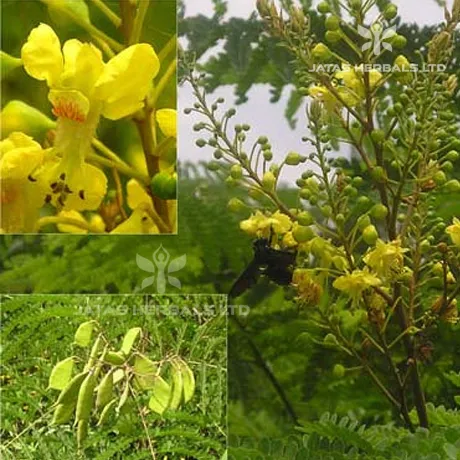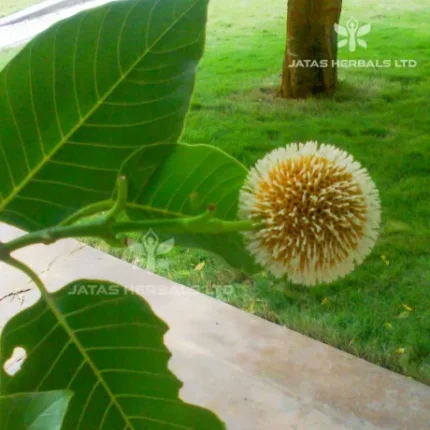It is described by Brihat Trayi in their works. It is mentioned as ‘Kucandana’ in Dhanvantari nighantu and Raja nighantu. Bhavamishra quoted it as Patanga. It should not be confused with Raktacandana (Pterocarpus santalinus). In A.H.Ut. 32/31 both have been mentioned as same drugs.
Botanical Description – It is a small to medium-sized, shrubby tree, 4-8(-10) m tall; trunk up to 14 cm in diameter; bark with distinct ridges and many prickles, greyish brown; young twigs and buds hairy, brownish. Leaves stipulate, bipinnate, alternate, 20-45(-50) cm long, 10-20 cm broad, with 8-16 pairs of up to 20 cm long pinnae; pinnae with prickles at the base and with 10-20 pairs of oblong, 10-20 mm x 6-10 mm long, subsessile leaflets, very oblique at base, rounded to emarginated at apex. Flowers in terminal panicles, racemes pubescent, primary penducles 30-40 cm long, the flowering 9-15 cm long, bracts ovate-acuminate, about 6 mm long, flowers fragrant, 2-3 cm long, 5-merous; sepals glabrous, petals pubescent, the superior one smaller; calyx tube 3 mm long; corolla yellow, uppermost lobes cuneate, other obovate, all clawed and gland-punctate; stamens 10, filaments densely tomentose in the lower half; ovary superior, pubescent. Fruit a dehiscent pod, glabrous, thick, flattened, obliquely oblong, prominently beaked, woody, polished-brown, 7-10 cm x 3-4 cm, 2-3(-5) seeded. Seeds ellipsoid, flattened, 18-20 mm x 10-12 mm, brown.
The origin of C. sapan is not certain, but is thought to be in the region from central and southern India through Indo-China to Peninsular Malaysia. It is cultivated and naturalized in many parts of Malesia and also in central India to Hawaii. It is small spiny tree bearing red flowers. It grows in most parts of India.
Major Chemical Constituents– Heartwood- α amyrin glucoside, alanine, thrconine, oil; caesalpin J & P. protosappanin A, B & C
Part Used– Heart-wood
Dosage– Decoction 50-100 ml
Research–
(1) Two aromatic compounds (I&II) possessed antihyper cholesterolaemic activity (Phytochem., 1985, 24, 2403).
(2) Protosappanin A showed weak sedative effect at 42.0 mg/kg, i.p. in mice induced by hexobarbital (Chem. Pharm. Bull. 1986, 34, 1).





Reviews
There are no reviews yet.